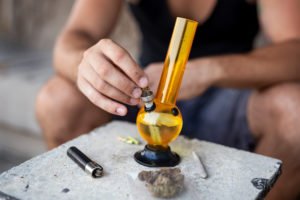
Arizona law makes using or possessing drug paraphernalia with the intent to use it (ARS 13-3415) a class 6 felony charge, carrying up to two years in prison. Although defendants are typically granted probation instead of prison, having any drug-related felony conviction can cause future employers to pass them over for jobs. Therefore, anyone facing paraphernalia charges is advised to fight the case in attempt to get the charges dismissed.1
Three common defenses to fight possession of drug paraphernalia charges include 1) there was no intent to use the paraphernalia; 2) there was no paraphernalia; or 3) the police committed misconduct.
Note that first-time drug offenders may be able to get paraphernalia criminal charges dismissed through a TASC diversion program. Or it may be possible to get the charge reduced to a misdemeanor conviction as part of a plea deal.
1. There was no intent to use the paraphernalia
Under Arizona drug law, simple possession of drug paraphernalia is no crime unless the defendant intended to use it.
Example: Jamie and Robert are roommates. Eventually Jamie moves out, leaving his bong in the closet. Here, Robert is violating no law as long as he has no intent to use the bong.
Another defense is that the defendant did not possess the paraphernalia at all, which means that the defendant had no control over the paraphernalia.
Example: Jamie and Robert are roommates. Robert keeps his bong in his room in a locked safe only he can access, and he never tells Jamie about it. Here, Jamie does not possess the bong because he has no physical control over it and is not aware that the bong is even there.
Typical evidence in these drug crime cases includes surveillance video, eyewitness testimony, and drug test results.
2. There was no paraphernalia
Sometimes police mistake perfectly innocent objects such as kitchen spoons or insulin syringes as paraphernalia meant for drug use or other drug offenses. Unless the D.A. can show that the objects in question qualify as drug paraphernalia, the ARS 13-3415 charge should be dropped.
Arizona law defines drug paraphernalia as:
[A]ll equipment, products and materials of any kind that are used, intended for use or designed for use in planting, propagating, cultivating, growing, harvesting, manufacturing, compounding, converting, producing, processing, preparing, testing, analyzing, packaging, repackaging, storing, containing, concealing, injecting, ingesting, inhaling or otherwise introducing into the human body a drug[.]
When determining whether an object qualifies as paraphernalia, Arizona courts consider the following 14 factors:
- Statements by an owner or by anyone in control of the object concerning its use.
- Prior convictions, if any, of an owner, or of anyone in control of the object, under any state or federal law relating to any drug.
- The proximity of the object, in time and space, to a drug crime.
- The proximity of the object to drugs.
- The existence of any residue of drugs on the object.
- Direct or circumstantial evidence of the intent of an owner, or of anyone in control of the object, to deliver it to persons whom he knows, or should reasonably know, intend to use the object to facilitate a drug crime.
- Instructions, oral or written, provided with the object concerning its use.
- Descriptive materials accompanying the object that explain or depict its use.
- National and local advertising concerning its use.
- The manner in which the object is displayed for sale.
- Whether the owner, or anyone in control of the object, is a legitimate supplier of like or related items to the community, such as a licensed distributor or dealer of tobacco products.
- Direct or circumstantial evidence of the ratio of sales of the object to the total sales of the business enterprise.
- The existence and scope of legitimate uses for the object in the community.
- Expert testimony concerning its use.
Drug paraphernalia includes the following:
- Kits used, intended for use or designed for use in planting, propagating, cultivating, growing or harvesting any species of plant that is a drug or from which a drug can be derived.
- Kits used, intended for use or designed for use in manufacturing, compounding, converting, producing, processing or preparing drugs.
- Isomerization devices used, intended for use or designed for use in increasing the potency of any species of plant that is a drug.
- Testing equipment used, intended for use or designed for use in identifying or analyzing the strength, effectiveness or purity of drugs, other than narcotic drug testing products that are used to determine whether a controlled substance contains fentanyl or a fentanyl analog.
- Scales and balances used, intended for use or designed for use in weighing or measuring drugs.
- Diluents and adulterants, such as quinine hydrochloride, mannitol, mannite, dextrose and lactose, used, intended for use or designed for use in cutting drugs.
- Separation gins and sifters used, intended for use or designed for use in removing twigs and seeds from, or in otherwise cleaning or refining, marijuana.
- Blenders, bowls, containers, spoons and mixing devices used, intended for use or designed for use in compounding drugs.
- Capsules, balloons, envelopes and other containers used, intended for use or designed for use in packaging small quantities of drugs.
- Containers and other objects used, intended for use or designed for use in storing or concealing drugs.
- Hypodermic syringes, needles and other objects used, intended for use or designed for use in parenterally injecting drugs into the human body.
- Objects used, intended for use or designed for use in ingesting, inhaling or otherwise introducing marijuana, a narcotic drug, a dangerous drug, hashish or hashish oil into the human body, such as:
- Metal, wooden, acrylic, glass, stone, plastic or ceramic pipes with or without screens, permanent screens, hashish heads or punctured metal bowls.
- Water pipes.
- Carburetion tubes and devices.
- Smoking and carburetion masks.
- Roach clips, meaning objects used to hold burning material, such as a marijuana cigarette, that has become too small or too short to be held in the hand.
- Miniature cocaine spoons and cocaine vials.
- Chamber pipes.
- Carburetor pipes.
- Electric pipes.
- Air-driven pipes.
- Chillums.
- Bongs.
- Ice pipes or chillers.
3. The police committed misconduct
If law enforcement found the alleged paraphernalia through an illegal search, the defense attorney can file a motion to suppress requesting the court to disregard the illegally-obtained evidence. If the judge grants the motion to suppress, the D.A. may be left with too weak of a case to pursue a criminal conviction.
Other types of police misconduct which may be enough to get a case dismissed are if the police coerced a confession, entrapped the defendant, or interrogated the defendant following an arrest without reading the Miranda rights.

Call our law firm for legal advice on your criminal case. Our criminal defense attorneys offer free consultations.
Facing illegal drug charges? Contact our law office to discuss how we may be able to get your charges reduced or dismissed with no felony drug conviction and no jail time. Our criminal defense lawyers create attorney-client relationships throughout Arizona, including Phoenix, Gilbert, Mesa, Tempe, Scottsdale, and more.
Legal References
- Arizona Revised Statute 13-901.01 (Proposition 200); see also State v. Estrada, (Court of Appeals of Arizona, Division One, Department E, 2000) 197 Ariz. 383, 4 P.3d 438, 316 Ariz. Adv. Rep. 9; see also State v. Soza, 249 Ariz. 13 (Court of Appeals of Arizona, Division One, 2020) 249 Ariz. 13, 464 P.3d 696.

